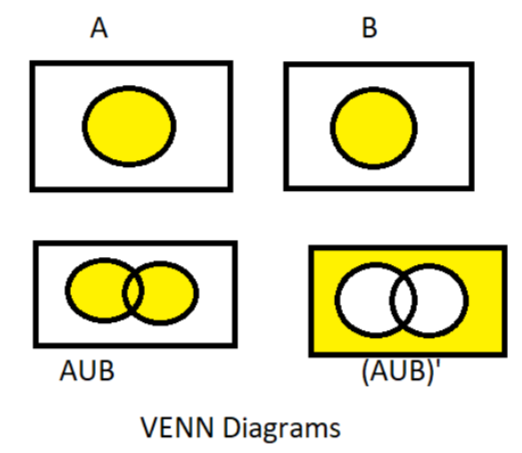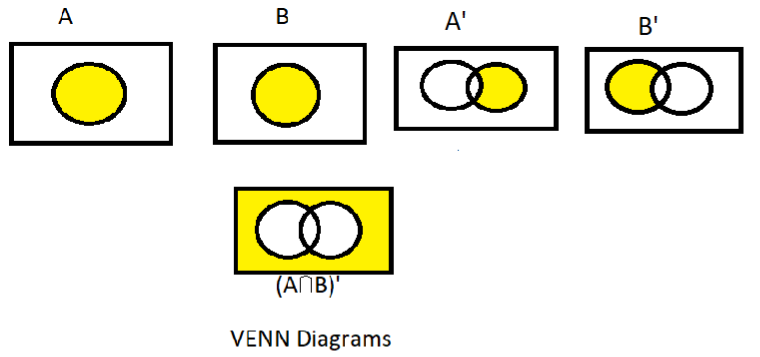
Use Venn diagrams to verify De’ Morgan’s law of complementation ${\left( {A \cup B} \right)^\prime } = \left( {A' \cap B'} \right)$
Answer
474.3k+ views
Hint: In this particular question use the concept that if set A has particular elements and set B has also some particular elements different from set A but some elements are same then in the set $\left( {A \cup B} \right)$ has all the elements containing set A and set B, common terms only written one time, in the set A’ there is no element which is in set A, so A’ is also called as a null set, so use these concepts to reach the solution of the question.
Complete step-by-step solution:
We have to verify using Venn diagrams De’ Morgan’s law of complementation i.e. ${\left( {A \cup B} \right)^\prime } = \left( {A' \cap B'} \right)$
I.e. complement of the union of the two sets is equal to the intersection of the complements of the respective set.
Now consider the LHS of the above equation we have,
$ \Rightarrow {\left( {A \cup B} \right)^\prime }$
Now as we know that if set A has particular elements and set B has also some particular elements different from set A but some elements are the same then in the set $\left( {A \cup B} \right)$ (i.e. A union B) has all the elements containing set A and set B, common terms only written one time, as shown in the Venn diagrams below.
Now ${\left( {A \cup B} \right)^\prime }$ is nothing but the complement of $\left( {A \cup B} \right)$ as shown in the Venn diagram below.

So ${\left( {A \cup B} \right)^\prime }$ is a null set i.e. a set which does not contain any elements.
Now consider the RHS of the above equation we have,
$ \Rightarrow \left( {A' \cap B'} \right)$
Now as we know that in set A’ there is no element of A as shown in the Venn diagram below similarly for the B’ or we can say that A’ and B’ is the complement of A and B respectively.
So A’ and B’ have no elements of A and B respectively.
So, $\left( {A' \cap B'} \right)$ has also no elements of A and B as shown below in the Venn diagrams.

So from the first and second Venn diagram, we can say that
LHS = RHS
Hence proved.
Note: Whenever we face such types of questions the key concept we have to remember is that always recall the following symbols which is given as,
$ \cup $ = union
$ \cap = $Intersection
$A'$ = complement of A
And the other De’ Morgan’s law is given as ${\left( {A \cap B} \right)^\prime } = \left( {A' \cup B'} \right)$
Complete step-by-step solution:
We have to verify using Venn diagrams De’ Morgan’s law of complementation i.e. ${\left( {A \cup B} \right)^\prime } = \left( {A' \cap B'} \right)$
I.e. complement of the union of the two sets is equal to the intersection of the complements of the respective set.
Now consider the LHS of the above equation we have,
$ \Rightarrow {\left( {A \cup B} \right)^\prime }$
Now as we know that if set A has particular elements and set B has also some particular elements different from set A but some elements are the same then in the set $\left( {A \cup B} \right)$ (i.e. A union B) has all the elements containing set A and set B, common terms only written one time, as shown in the Venn diagrams below.
Now ${\left( {A \cup B} \right)^\prime }$ is nothing but the complement of $\left( {A \cup B} \right)$ as shown in the Venn diagram below.

So ${\left( {A \cup B} \right)^\prime }$ is a null set i.e. a set which does not contain any elements.
Now consider the RHS of the above equation we have,
$ \Rightarrow \left( {A' \cap B'} \right)$
Now as we know that in set A’ there is no element of A as shown in the Venn diagram below similarly for the B’ or we can say that A’ and B’ is the complement of A and B respectively.
So A’ and B’ have no elements of A and B respectively.
So, $\left( {A' \cap B'} \right)$ has also no elements of A and B as shown below in the Venn diagrams.

So from the first and second Venn diagram, we can say that
LHS = RHS
Hence proved.
Note: Whenever we face such types of questions the key concept we have to remember is that always recall the following symbols which is given as,
$ \cup $ = union
$ \cap = $Intersection
$A'$ = complement of A
And the other De’ Morgan’s law is given as ${\left( {A \cap B} \right)^\prime } = \left( {A' \cup B'} \right)$
Recently Updated Pages
Glucose when reduced with HI and red Phosphorus gives class 11 chemistry CBSE

The highest possible oxidation states of Uranium and class 11 chemistry CBSE

Find the value of x if the mode of the following data class 11 maths CBSE

Which of the following can be used in the Friedel Crafts class 11 chemistry CBSE

A sphere of mass 40 kg is attracted by a second sphere class 11 physics CBSE

Statement I Reactivity of aluminium decreases when class 11 chemistry CBSE

Trending doubts
The reservoir of dam is called Govind Sagar A Jayakwadi class 11 social science CBSE

10 examples of friction in our daily life

Difference Between Prokaryotic Cells and Eukaryotic Cells

State and prove Bernoullis theorem class 11 physics CBSE

Proton was discovered by A Thomson B Rutherford C Chadwick class 11 chemistry CBSE

State the laws of reflection of light




